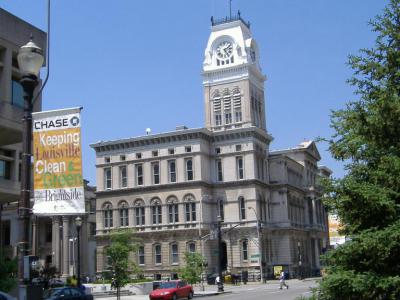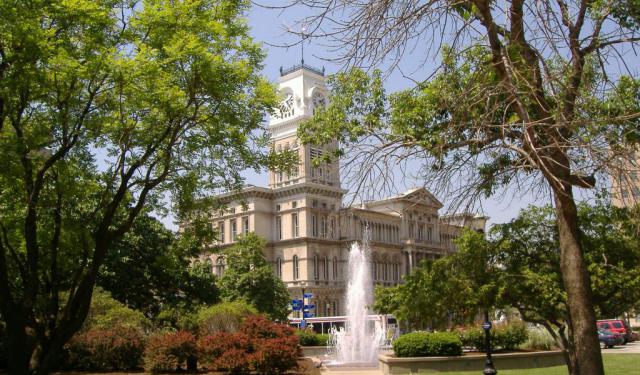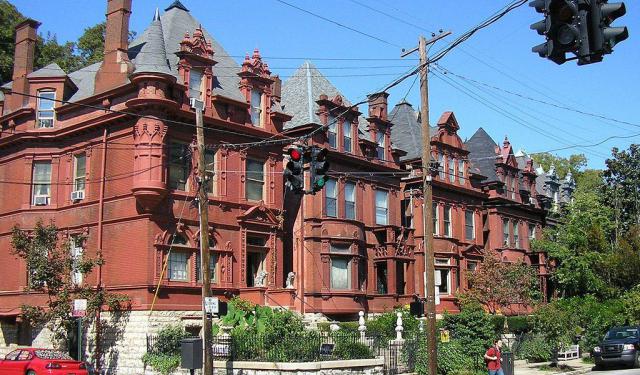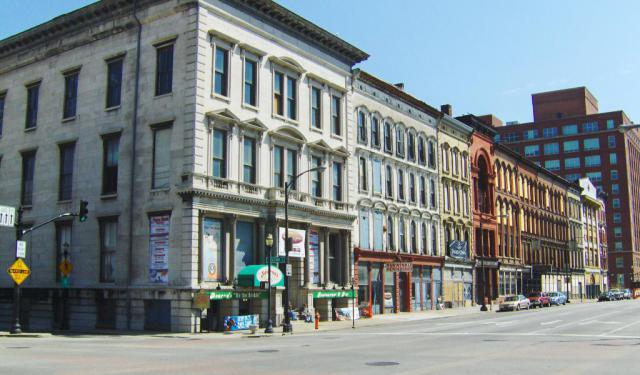
City Hall, Louisville
Louisville City Hall is a historic building whose construction lasted from 1870 and 1873. Originally it was designed as the seat of the local city government; since the merger of the former City of Louisville with Jefferson County, Kentucky, it now primarily houses the offices and chambers of the Louisville Metro Council.
The building's architecture is a striking blend of Italianate and Second Empire, both styles popular at the time in civic buildings, as well as Beaux Arts and Romanesque Revival. Designs on the building represented the city's outlook in the post-Civil War era, which was very optimistic. The pediment over the main entrance features a relief of the city seal and a train steaming forward past Southern flora with the inscription, "Progress, 1871." Other engravings, over the tympana of the side windows, depict livestock heads, representing the importance of agriculture in Louisville's early history.
The building has three full stories with a raised basement. While the exterior of the structure remained almost unchanged throughout its history, the interior was exposed to a number of grand restoration works. In 1909 an attachment was linked to the main building. The annex was designed in Greco-Roman style by Cornelius Curtin. The most prominent feature of the City Hall is the 195-foot four-faced clock tower with mansard roof, not completed until 1876 after an earlier one burned in 1875. The tower included a three-ton bell which rang until 1964, when the clock broke. It was repaired in 1968 but then broke again in the 1970s. It was finally fixed in 1991.
In 1976 the City Hall building was placed on the National Register of Historic Places.
The building's architecture is a striking blend of Italianate and Second Empire, both styles popular at the time in civic buildings, as well as Beaux Arts and Romanesque Revival. Designs on the building represented the city's outlook in the post-Civil War era, which was very optimistic. The pediment over the main entrance features a relief of the city seal and a train steaming forward past Southern flora with the inscription, "Progress, 1871." Other engravings, over the tympana of the side windows, depict livestock heads, representing the importance of agriculture in Louisville's early history.
The building has three full stories with a raised basement. While the exterior of the structure remained almost unchanged throughout its history, the interior was exposed to a number of grand restoration works. In 1909 an attachment was linked to the main building. The annex was designed in Greco-Roman style by Cornelius Curtin. The most prominent feature of the City Hall is the 195-foot four-faced clock tower with mansard roof, not completed until 1876 after an earlier one burned in 1875. The tower included a three-ton bell which rang until 1964, when the clock broke. It was repaired in 1968 but then broke again in the 1970s. It was finally fixed in 1991.
In 1976 the City Hall building was placed on the National Register of Historic Places.
Sight description based on Wikipedia.
Want to visit this sight? Check out these Self-Guided Walking Tours in Louisville. Alternatively, you can download the mobile app "GPSmyCity: Walks in 1K+ Cities" from Apple App Store or Google Play Store. The app turns your mobile device to a personal tour guide and it works offline, so no data plan is needed when traveling abroad.
City Hall on Map
Sight Name: City Hall
Sight Location: Louisville, USA (See walking tours in Louisville)
Sight Type: Attraction/Landmark
Guide(s) Containing This Sight:
Sight Location: Louisville, USA (See walking tours in Louisville)
Sight Type: Attraction/Landmark
Guide(s) Containing This Sight:
Walking Tours in Louisville, Kentucky
Create Your Own Walk in Louisville
Creating your own self-guided walk in Louisville is easy and fun. Choose the city attractions that you want to see and a walk route map will be created just for you. You can even set your hotel as the start point of the walk.
Louisville Introduction Walking Tour
Poised on the banks of the Ohio River, Kentucky's largest city Louisville blends small-town charm with urban sophistication. The first European settlement in the vicinity of modern-day Louisville was on Corn Island, established in 1778 by Col. George Rogers Clark, credited as the founder of the city. Two years later, the Virginia General Assembly approved the town charter of Louisville. The... view more
Tour Duration: 2 Hour(s)
Travel Distance: 4.5 Km or 2.8 Miles
Tour Duration: 2 Hour(s)
Travel Distance: 4.5 Km or 2.8 Miles
Historical Old Louisville Walking Tour
The third largest urban district in the United States and the country's largest preservation district of Victorian-era buildings, the Old Town of Louisville is an ideal area in which to travel through the city's history. It is here that Louisville's oldest and most peculiar houses and other reminders of the past are concentrated, featuring a wealth of architectural styles.
... view more
Tour Duration: 1 Hour(s)
Travel Distance: 2.2 Km or 1.4 Miles
... view more
Tour Duration: 1 Hour(s)
Travel Distance: 2.2 Km or 1.4 Miles
Louisville Architecture Walking Tour
Louisville, Kentucky, is famous for its architectural marvels, featuring a combination of styles and eras, sizes and artistic directions, adding a great deal of uniqueness to the city panorama. Architecture buffs will be delighted at a chance to admire the elaborate edifices abounding the city.
One such iconic spot is Whiskey Row. Once a bustling hub of the local bourbon industry, it has been... view more
Tour Duration: 2 Hour(s)
Travel Distance: 2.8 Km or 1.7 Miles
One such iconic spot is Whiskey Row. Once a bustling hub of the local bourbon industry, it has been... view more
Tour Duration: 2 Hour(s)
Travel Distance: 2.8 Km or 1.7 Miles



